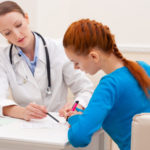More than one in five cases of anaphylaxis that occur in schools happen in people with no known allergies, and school staff are not always properly trained to handle them, a new study suggests.
"Bottom line, I think our findings underscore the need for continued education in the school setting," Martha White, MD, director of research at the Institute for Asthma and Allergy in Wheaton, Maryland, told Medscape Medical News.
Dr White presented the findings here at the American Academy of Pediatrics (AAP) 2015 National Conference.
The study highlights two different scenarios: people who experience their first anaphylaxis event and would benefit from epinephrine autoinjectors stocked by the school, and people with a diagnosis of anaphylaxis who may or may not have their injectors handy.
"We want to have this lifesaving medication at school," said session organizer and moderator Mandy Allison, MD, from the University of Colorado in Aurora.
Several states now have passed or are passing legislation that allows the school to stock lifesaving medication not designated to a specific person, she reported.
The data come from a web-based survey of schools participating in the EpiPen4Schools program, developed by Mylan Specialty, which distributes epinephrine autoinjectors to more than 30,000 elementary and high schools, free of charge, in the United States.
Of the 32,387 schools invited to participate in the survey from May to July 2014, 6019 responded. Most were completed by the school nurse.
There were 919 anaphylactic events reported by 607 (11%) of 5683 schools.
Information on the anaphylactic event was included in 852 of the completed surveys. People with no known allergies experienced 187 (22%) of the events, and students experienced 757 (89%) of the events. Of the 757 events experienced by students, 32% were in grade school, 19% were in middle school, and 49% were in high school.
Food, Insect Bites, Other Triggers
Triggers were included in 847 of the surveys: 62% of the triggers were food, 20% were unknown, 10% were insect bites, 7% were environmental or related medication or health factors, and 1% were latex.
Treatments were included in 851 of the surveys: 75% were epinephrine autoinjectors, 24% were antihistamines, and 1% were unknown.
"Epinephrine is the only approved treatment, yet even in the schools that received free EpiPens, only 75% used them," Dr White pointed out. "That is an opportunity for education, because antihistamines won't stop anaphylaxis."
There were no deaths reported, suggesting that those who received antihistamines most likely had mild symptoms that would have cleared anyway, she pointed out.
Of the 636 epinephrine-treated events, 49% used autoinjectors from the school supply and 45% used the person's personal autoinjector.
Use of the school supply does not necessarily mean the individual did not have their own autoinjector with them. It might just have been easier for the school nurse to grab the stock pen than to go searching for the personal pen in an emergency, Dr White explained.
And, of course, the stock pen would have been used in all of the cases of first-time anaphylaxis treated with epinephrine, she added.
Trained to Treat
Of the 5613 schools that responded to questions about staff training, 36% reported that the only people trained to recognize the signs of anaphylaxis were the school nurse and a small number of others, 29% reported that most staff members were trained, and 31% reported that all staff members were trained. However, 54% of the schools permitted only the school nurse and select staff members to administer epinephrine.
"Teach the kids how to use the devices themselves, as long as they're mature enough to do it. For the adolescents, try to reinforce non-risk-taking and the avoidance of triggers. They need to be told this can kill you," Dr White advised.
"There's not always a nurse in every school, so other folks need to be trained to use these medications," Dr Allison told Medscape Medical News. "We still have a long way to go in terms of when to use epinephrine autoinjectors and what the indications are. They're probably being underutilized," she said.
"Our training should focus on school nurses, but also on the folks who are more likely to be present at the moment the reaction occurs. That's not always the nurse," she pointed out.
This can be a real problem if, for example, a child has an anaphylaxis event on the playground, said Dr White. In such a scenario, "the teacher has to transport the kid to the health room to get treated. That's an opportunity for education as well," she said.
She noted that many of her teenage patients know how to administer the epinephrine themselves, and that many teenage babysitters are trained to use the devices for their charges. "If I can train teenagers to do it, I'm sure the schools could train the teachers."
Dr Allison said that these data are fairly consistent with those from other publications, although there is not a huge database to compare them with. And, she said, these results are not ideal because of the extent of the missing data, both in the overall response rate and in the answering of individual questions.
"It's not the perfect study, but it is some of the better data that we have on a national level. It's starting to give us an idea of what's going on in schools," she added.
Dr White is a consultant for Mylan and has worked with most of the other companies that make allergy- and asthma-related products. Dr Allison has disclosed no relevant financial relationships.
American Academy of Pediatrics (AAP) 2015 National Conference. Presented October 24, 2015.
Source: http://www.medscape.com/viewarticle/853486 Miriam E. Tucker October 30, 2015







Join the conversation